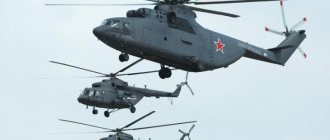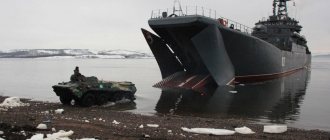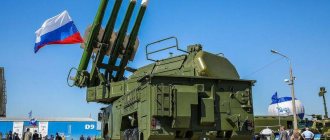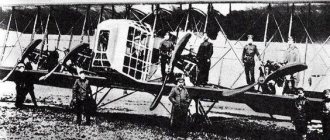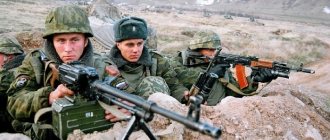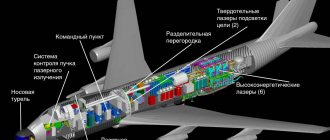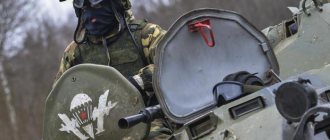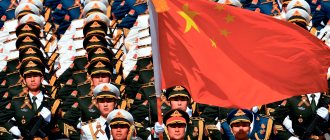By analogy with the ground forces of the Russian Federation, naval aviation dramatically increases the capabilities of the fleet. A Navy MA unit was created to solve several problems:
- search for and destruction of sea, air and ground targets;
- aerial reconnaissance and ship guidance;
- production/destruction of minefields;
- electronic warfare;
- search/rescue of victims;
- transportation and landing of special forces.
Navy Aviation
The main part of aviation is based on the shore, a smaller part of it - naval aviation - is located on the only aircraft-carrying cruiser in the Russian Federation, Admiral Kuznetsov. The composition includes only helicopters and airplanes; previously used seaplanes are now used by the Ministry of Emergency Situations for transportation and firefighting.
Naval aviation structure
The branch of force that before the destruction of the Soviet Union (1991) was called the “Air Force of the USSR Navy” is today called the Naval Aviation of the Navy of the Russian Federation (MA VMF). His tasks:
- search/destroy the combat forces of a potential enemy (convoys, landing forces, single ships, airplanes, helicopters, cruise missiles);
- covering detachments of warships during exercises/combat cruises from air strikes;
- directing strike forces at enemy naval formations, issuing target designation for the purpose of their destruction;
- conducting mine laying and electronic reconnaissance;
- air transportation, landing;
- search and rescue work.
Until 2008, the naval aviation forces included combat units of the Northern, Pacific, Black Sea, Baltic Fleet, as well as units of central subordination.
Helicopter of the Russian aviation fleet - Ka-27PS Source: Wikipedia.org
The combat strength of the military/training units included aircraft of missile-carrying, fighter, attack, anti-submarine, search and rescue, special, and transport aircraft.
MA units include several more types of aviation:
- intelligence;
- mine action;
- electronic warfare;
- auxiliary.
The latter name includes a wide range of aviation equipment designed to solve various tasks - electronic warfare, mine warfare, anti-submarine warfare, detection, guidance, control, communications, supplying fuel to the main aviation forces of the Navy, conducting search/rescue of people, carrying out transport (sanitary) operations.
It may be interesting: US Aircraft Carriers
After unifying the structure, the combat strength of naval aviation forces at their bases is divided into two categories:
- Deck-based (naval) aviation.
- Coastal aviation.
As a branch of the force, units of sea-based aviation forces perform special missions jointly with the Ground Forces/Aerospace Forces of the Ministry of Defense of the Russian Federation.
Casual women's Navy uniform
It is a set of a cap made of black wool, a black woolen skirt, a cream-colored blouse, a traditional tie with gold fastening and a waist belt, black shoes (or boots) and nude tights. Also included is a jacket.
A winter casual uniform involves wearing an astrakhan black beret, a wool coat, a skirt, a blouse, a belt, a tie and tights from the summer set described above, a black muffler and gloves. Shoes are boots or boots. The jacket is also available in a winter version of the uniform. It is allowed to wear a sweater, a demi-season raincoat, a cap and a hat with earflaps.
It is worth noting that some of the elements that exist in the kit now were introduced in 2014.
Now, having examined everyday naval attire, let's move on to other different types of naval uniform. There are several types of them, including:
- Front door.
- Office.
- Dembelskaya.
Also, since the times of the USSR, there has been a division into winter and summer forms.
Video: review of the new type of office uniform for Navy officers
Naval aviation of the Navy
The flagship of the Northern Fleet of the Russian Navy is the heavy aircraft-carrying cruiser Admiral of the Fleet of the Soviet Union Kuznetsov. It is capable of carrying on board a full-fledged air wing of attack and reconnaissance aircraft. Composition of Project 1143.5 TAVKR combat aircraft at the time of dry docking for the purpose of overhaul and modernization (2017):
- carrier-based fighters Su-33, MiG-29K, MiG-29KUB;
- training attack aircraft Su-25UTG;
- anti-submarine helicopters Ka-27, Ka-27PS and Ka-29;
- Ka-27RLD radar patrol helicopters.
The total number of aircraft that make up the TAVKR air wing of project 1143.5 is 44 units.
The heavy aircraft-carrying cruiser "Admiral of the Fleet of the Soviet Union Kuznetsov" is the only ship in the fleet adapted for take-off/landing of fighter and attack aircraft. Anti-submarine aircraft, deck-based multi-purpose helicopters developed by the joint-stock company (united design bureau) "Kamov", have crews of ships of 9 more projects:
| Projects of the Kamov Society | ||
| Project No. | Vessel type | Helicopter brand |
| 1144.2 | heavy nuclear missile cruiser "Orlan" | Ka-27PL, Ka-29, Ka-31 |
| 1164 | Atlant-class missile cruiser | Ka-27PL, Ka-25RTs |
| 1155 | large anti-submarine ship of the “Frigate” type | Ka-27PL |
| 22350 | frigate | Ka-27PL |
| 956 | destroyer | Ka-27 |
| 20380 | Steregushchiy-class corvette | Ka-27PL |
| 11540 | patrol ship | Ka-27PL |
| 11351, 11356, 11356R/M | patrol ship | Ka-27/Ka-27PS, Ka-28, Ka-31 |
In 2016-2017 On the ships of the Mediterranean operational-tactical squadron of the Russian Navy, the latest deck-based attack helicopters of the coaxial design Ka-52 “Katran” were tested.
The improvement of all types of sea-based aircraft is carried out with the aim of increasing stealth, increasing flight range/speed, equipping with high-precision missile weapons, electronic warfare (EW) and searching for submarines of a potential enemy. The tasks of the crews of sea-based aircraft/helicopters are to detect surface/underwater targets, collect/process information about a potential enemy, and issue target designation to neutralize or defeat him.
Su-33: the first naval fighter
The Su-33 can be called a deck-based version of the legendary Su-27, which was created by order of the Navy to protect the fleet from air attack. In 1989, the Su-27K fighter (as the Su-33 was then called) made the first “regular” landing of an aircraft on the deck of an aircraft carrier in Russian history. For many years, the Su-33 became the only naval fighter of the Russian Navy.
Photo: Russian Ministry of Defense / wikimedia.org
Sukhoi Design Bureau specialists managed to quickly put the new carrier-based aircraft into service. The fact is that the weapon system of the serial front-line fighter Su-27 did not require any special changes for the ship version. Of course, the naval version of the fighter was modified for basing the aircraft on a ship, for example, a wing folding system was installed. In addition, reinforced landing gear supports and a brake hook were required.
The Su-33 is based on the heavy aircraft-carrying cruiser of the Russian Navy "Admiral Kuznetsov". As part of the Admiral Kuznetsov air group, fighters were used in operations of the Russian armed forces in Syria. This was the first combat use of carrier-based Su-33 aircraft in Russian history.
Coastal Aviation of the Navy
The composition of the coast-based naval aviation forces consists of combat and auxiliary aircraft/helicopters of various classes, permanently located at military airfields near the maritime borders of the Russian Federation and probable theaters of military operations, namely:
- Oceans – Atlantic, Pacific, Arctic.
- Seas - Black, Baltic.
The aircraft fleet includes the following aircraft models:
| Aviation fleet | |
| Model/modifications | Purpose |
| Su-27 | frontline fighter |
| Su-30 | multi-role fighter |
| MiG-31 (B/BS/BM) | high altitude fighter interceptor |
| Su-24 (M/MR) | frontline bomber |
| Su-25UTG | stormtrooper |
| L-39 | combat trainer aircraft |
| Be-12 | anti-submarine amphibious aircraft |
| Il-38 (N), Tu-142M, A-40 | anti-submarine aircraft |
| IL-22 | air command post |
| IL-20 | electronic warfare and reconnaissance aircraft |
The number of fighter-bomber aircraft in the coastal composition of the naval aviation of the Russian Navy is 139 units. Anti-submarine operations are carried out from the boards of 48 aircraft, electronic warfare and general management of the actions of army forces at sea - from 4. The transport aviation of the navy includes 53 aircraft: multi-purpose transport aircraft An-12, An-24, An-26, An-72, An-140, passenger aircraft for transporting military personnel and performing special tasks Il-18, Tu -134, Tu-154.
Helicopter units of coastal aviation include the following types of machines:
| Helicopter units of coastal aviation | |
| Model/modifications | Purpose |
| Mi-8 (T/TM/AMTSh), Mi-14 (PS), Ka-226 (T) | multi-purpose |
| Mi-24 (P) | shock |
| Ka-27 (M/PL/PS) | anti-submarine |
| Ka-29 | transport-combat |
| Ka-31R (Ka-27RLD) | radar patrol helicopter |
Rotary-wing vehicles fully perform the functions of supplying the command of naval formations with information about the location and number of forces of a potential enemy, the nature of their maneuvering and the general surface situation.
Be-200: amphibious jet
It was with seaplanes that naval aviation once began. The most modern representative of Russian hydroaviation is the Be-200. By the way, this is the only amphibious jet aircraft in the world. The Be-200 can operate both on land - airfields, and on water - reservoirs deeper than 2.6 m. The Be-200 can land on water even in meter-high waves.
Photo: Alexander Markin / wikimedia.org
The Be-200 is an excellent help in fighting forest fires - such an aircraft does not need to return to the airfield every time to fill its tanks with water. Gliding along the surface of a suitable body of water, the machine can take on board 12 tons of water in just 14 seconds. Be-200 aircraft have been fighting fires since 2004, and not only in Russia. Our amphibian helped firefighters in France, Portugal, Italy, Greece, Indonesia, and Israel. Recently, a Be-200 naval aviation aircraft of the Russian Navy was sent to Turkey to extinguish fires.
Aviation composition (leaders and commanders)
The first commander of the Directorate of Aviation/Aeronautics in the Fleet (UMAiV) in 1914 was captain of the second rank A. A. Tuchkov. He was appointed to this position by decree of Emperor Nicholas II. Following him was the general management of the actions of aviation forces, the combat service of naval pilots during the First World War of 1914-1916, and the Civil War of 1918-1922. carried out:
- B. R. Miklashevsky;
- I. N. Dmitriev;
- B. A. Shcherbachev;
- A. P. Onufriev;
- N. F. Chernov;
- S. A. Lishin;
- I. N. Dmitriev;
- S. E. Stolyarsky;
- M. F. Pogodin.
In 1923, the position of head of the Naval Aviation forces of the Workers' and Peasants' Red Army was abolished. Only in 1935, taking into account the combat experience of Germany, Great Britain, the USA, and Japan, was it decided to revive aviation in the navy as a branch of the force. During Soviet times, as well as after the Russian Federation became an independent state, until its reorganization in 2010, it was commanded by 15 military leaders:
- V. K. Bergstrom;
- F. G. Korobkov;
- S. F. Zhavoronkov;
- P. N. Lemeshko;
- A. M. Shuginin;
- E. N. Preobrazhensky;
- I. I. Borzov;
- A. A. Mironenko;
- G. A. Kuznetsov;
- V. P. Potapov;
- V. G. Deineka;
- I. D. Fedin;
- Yu. D. Antipov;
- V. P. Uvarov;
- N.V. Kuklev.
The head of the air force of the maritime aviation fleet of the Russian Navy since 2010 is the Honored Military Pilot of the Russian Federation, Hero of Russia, Major General Igor Sergeevich Kozhin.
As independent units subordinate to the command (headquarters) of the Navy MA, there are naval aviation forces at four operational-strategic formations:
- Northern Fleet;
- Pacific Fleet;
- Black Sea Fleet;
- Baltic Fleet,
as well as on the Mediterranean operational-tactical squadron. Composition: battle banners of air divisions and brigades, individual military units. General management of the actions of Naval Aviation forces is carried out by the Main Command of the Russian Navy from Moscow.
History of creation
Naval aviation units of the Russian Navy celebrate their “Birthday” on July 17. This branch of the military is very specific, protecting the boundaries of two elements at once - water and sky. The history of the development of naval aviation can be represented by the following dates:
- 1910 - in the summer the Antoinette-4 aircraft was purchased for the Naval Department, the first flight on it was made by Lieutenant Dorozhinsky from the Kulikovo airfield in Sevastopol;
- 1912 - Vice Admiral Grigorovich signed an order in May to create air detachments in the fleet, in August the first seaplane was launched on Vasilyevsky Island in St. Petersburg;
- 1914 - The First World War prevented the deployment of air detachments in the Pacific Fleet, and the existing units were ordered transferred to the signal service;
- 1916 - On July 17, four Russian aircraft repelled an attack by the same number of German aircraft in the Baltic, which is considered to be Russian Navy MA Day;
- 1916 - the structure of units was formed - a detachment of 4 - 8 aircraft, a division of 2 - 4 detachments, a brigade of 2 - 4 divisions, a division of at least 2 brigades, the relationship between the chiefs/commanders of aviation and naval aircraft is regulated by the Regulations on the spacecraft division (ship aviation);
- 1916 - creation of the Van flotilla (Lake Van, Turkey) of two M-5 seaplanes under the command of midshipman Ivanov to support the Baku detachment, Peipus hydroaviation detachment (Lake Peipus);
- 1917 - formation of a special-purpose brigade with the powers of a division to support the Arctic Ocean flotilla;
- 1917 - to manage fleet aviation, the UMAiV department was created, headed by A. A. Tuchkov;
- 1917 - V.I. Lenin appoints A.P. Onufriev as commissar of the MA, then aviation joins the UVOFLOT air force and leaves subordination;
- 1918 - The Baltic division is evacuated to the Volga, the command changes its status to a special purpose brigade (three divisions of eight detachments);
- 1918 The Black Sea Division ceases to exist after the loss of personnel and equipment;
- 1920 - naval aviation was subordinated to the Red Army Air Fleet, M.F. Pogodin became assistant for hydroaviation, then A.P. Onufriev.
Subsequently, from 1920, for 18 years, the Russian Naval Aviation Fleet was subordinate to the Red Army Air Force. In the 30s, Polar Aviation was formed from MA pilots.
Then the People's Commissariat of the Navy again allocated Naval Aviation in December 1937, the further development of this type of troops continues:
- 1937 - S. F. Zhavoronkov becomes chief of naval aviation (Marshal of the USSR Aviation since 1944);
- 1941 - the formation of three detachments from civil aviation at the end of June for transport within fleets, assigning attack aircraft and combat aircraft units to the Border Guard Troops belonging to the NKVD;
- 1941 - creation of a special strike group of 15 DB-3T aircraft by decree of the People's Commissar of the USSR Navy N. G. Kuznetsov;
- 1941 - in the fall, units and formations that had lost their military equipment were disbanded, the crews were sent to the rear.
In 1942, the 1st, 5th and 13th Baltic Regiment, 72nd Regiment of the Northern Fleet were awarded the title of Guards. A little later, 2.5, 6 and 8 regiments of the Black Sea Fleet were added to them. After the addition of Pe-2 and Il-2 bombers and attack aircraft to naval aviation in the next two years, the corresponding naval aviation units were added.
In 1943, instead of floating boats, reconnaissance units began to use foreign bombers and fighters Boston, Airacobra P-39, Kittyhawk, Tomahawk and P-40.
In the last years of the war, the Northern Fleet added the 14th SAD division, the Pacific 15th and 15th SAD, and the Black Sea 13th PAD. After the Victory, the assault units of the Navy aviation were liquidated, but three divisions 17, 18 SAD in the Pacific Fleet, 19 MTAD Civil Command of the Navy were created. Taking into account the effectiveness of combat operations during the Second World War, the further development of naval aviation occurred as follows:
- 1946 - abolition of the Civil Code of the Navy, subordination to the Minister of the Armed Forces, renaming the Navy Air Force to Naval Aviation, transition to peacetime staff;
- 1946 - disbandment of all flying units due to the decommissioning of MBR-2 flying boats;
- 1947 - division of the TF into the 5th and 7th Pacific Fleets, the Baltic Fleet into the 4th and 8th Baltic Fleets.
Until 1950, 3 divisions were reduced, the flotillas lost bases, defensive areas and aviation itself. Starting next year, fighter pilots began retraining on MiG-15 and MiG-17 jet aircraft. The 1951 reform re-equipped units with torpedo bombers instead of mine-torpedo aircraft.
In 1953, the Pacific Fleet became united again, and in 1956 the Baltic Fleet did the same.
In 1953, the Fleet Aviation was again renamed the Pacific Fleet Air Force, Northern Fleet, Baltic Fleet and Black Sea Fleet, respectively. At the same time, helicopters entered service:
- The Ka-15s were based on ships;
- Mi-4s were formed into separate squadrons on land.
Later in 1958 they were reorganized into OAPV regiments. Part of the fighter aviation was reassigned to the air defense forces, for whose commanders pilots in vests became a headache. A completely new unit - Naval Missile-Carrying Aviation MPA - arose in 1961. As new combat vehicles emerged, they were equipped with naval aviation units of the fleets:
- 1962 – supersonic reconnaissance aircraft Tu-22R;
- 1963 – modification of the Tu-95RTs reconnaissance aircraft;
- 1965 – amphibious aircraft Be-12;
- 1967 – anti-submarine aircraft Il-38;
- 1969 – Tu-142 (long-range complex);
- 1972 – Ka-27 helicopter for long-range patrol from the shore and on board a ship.
In the 70s, naval aviation began to develop long-distance airfields outside the USSR:
- Pacific Ocean - Vietnam;
- Atlantic Ocean - Angola, Guinea and Cuba;
- Indian Ocean - Yemen, Somalia, Ethiopia;
- Mediterranean Sea - Syria and Egypt.
Since 1974, the missile carrier with variable wing geometry Tu-22M2 entered the MRA of the Baltic and Black Sea Fleet.
Six years later it became a standard part of the Pacific Fleet's weapons. Aircraft-carrying cruisers TAVKR, suitable for vertical take-off aircraft Yak-38, were launched in the mid-70s. The cruiser TAVKR Kyiv was built for the Northern Fleet, and Novorossiysk and Minsk for the Pacific Fleet.
In 1975, coastal assault units with Su-17M aircraft were created. In 1979, the 11th Navy Air Group, reporting directly to Moscow, was created to meet the needs of ekranoplanes of the Orlyonok MDE type.
In 1980, the AVMF was once again renamed the Navy Air Force. Today's only aircraft-carrying heavy cruiser, Admiral Kuznetsov, was commissioned in 1991.
Navy Naval Aviation Day
On July 15, 1996, the Commander-in-Chief of the Russian Navy, Fleet Admiral Felix Gromov, signed Order No. 253 “On the establishment of annual holidays and professional days in the specialty.” From now on, every year on July 17, the professional holiday of air fleet pilots assigned to the Russian Navy is celebrated - Naval Aviation Day. This day is celebrated in military units of coastal aviation and on ships whose crews include airplane and helicopter pilots.
MiG-29K: a new takeoff “like an airplane”
The MiG-29K shipborne fighter became one of the first domestic combat aircraft that can land and take off from a ship “like an airplane.” By the way, this happened for the first time on the same day when the Su-33 took off from the deck - November 1, 1989. However, the development program for the deck-based MiG was suspended and was revived only in the 2000s. This was facilitated by the interest of a foreign customer - in 2004, a contract was signed with India for the purchase of a large batch of naval fighters in single-seat (MiG-29K) and double-seat (MiG-29KUB) versions.
Photo: Russian Ministry of Defense / wikimedia.org
A little later, the MiG-29K found its niche in the Russian Navy. Large orders made it possible to improve the fighter to level 4++. At the same time, the shipborne MiG-29K is no longer just an improved MiG-29, but one might say a new aircraft. The vehicle meets the high requirements for carrier-based fighters and is equipped with a landing hook and a reinforced airframe structure. The MiG-29K has a “glass cockpit”, that is, all instruments in the pilot’s cockpit are digital. Modern avionics allows the use of the entire range of high-precision missiles and aerial bombs.
Admiral-submariner appointed new Commander-in-Chief of the Russian Navy
Such a “bouquet” of personnel changes in our Navy, which Russian Defense Minister Sergei Shoigu presented to all participants in the conference call on May 8, has not happened for a long time. The head of the military department announced that four admirals were changing their positions by presidential decree. True, for one of them, 64-year-old Commander-in-Chief of the Navy Vladimir Korolev, his military service has ended. He leaves his post and goes to work for the United Shipbuilding Corporation. Shoigu “sweetened” the sad moment of Korolev’s parting with the fleet with a bold compliment to the admiral, respectfully reminding him that he had spent more than 45 years in military service, and “under his leadership, the naval forces successfully fought international terrorism, and after a long break, they resumed their presence in the World Ocean. Under Korolev, the Navy received the latest submarines of the Borey and Yasen projects,” the minister noted.
Instead of Korolev, the former commander of the Northern Fleet, Admiral Nikolai Evmenov, will now stand on the main captain's bridge of our Navy.
What is known about the new Commander-in-Chief of the Navy?
He was born in 1962 in Moscow, graduated from the Higher Naval School of Diving and the Naval Academy. He has an impressive track record: he was a first mate and then a submarine commander, division commander, commander of the Submarine Forces of the Pacific Fleet, chief of staff of the Northern Fleet and its commander. Awarded three orders.
Under him, a “revolutionary” technique was used in training the crew of the nuclear submarine “Prince Vladimir”. She became the first submarine in Russian history whose crew mastered the structure of the ship even before the submarine became part of the Navy. This process went in parallel with factory and state exams.
However, the new Commander-in-Chief of the Navy at one time became famous not only for this. One day, a video appeared on the Internet, secretly filmed by one of Evmenov’s subordinates. In it, the admiral addresses the formation of sailors in “very expressive language” after an accident involving a drunken serviceman, which resulted in the death of a civilian. The video received as many as 465 thousand views. To the credit of Nikolai Anatolyevich (whose emotionality can be understood), after publishing the video on the Internet, he announced a “month without swearing” for the Northern Fleet. And he showed a personal example in this.
It is also known that Evmenov is an avid hockey player who does not like to lose. One day, after his team’s defeat, he smashed his stick into pieces out of anger. The Ministry of Defense is already talking that the Commander-in-Chief of the Navy may appear in the hockey team for which Shoigu plays...
By the same decree of the President of the Russian Federation, Vice Admiral Igor Osipov was appointed commander of the Black Sea Fleet, and Vice Admiral Alexander Moiseev was appointed commander of the Northern Fleet.
Dress uniform for officers and midshipmen of the Navy
There are several types of dress uniforms for different weather/climate conditions. The headdress in the ceremonial set is a white/black cap (summer or winter/woolen) or a hat with earflaps made of black fur (colonels, senior officers and captains of the first rank wear an astrakhan hat with a visor).
A mandatory element of any type of officer's and midshipman's dress uniform is a black tie with a gold tack. Also included is a wool jacket: black (dress) or white (summer). Black wool trousers, a white shirt and a golden belt are the basis of any dress uniform.
Shoes – black or white shoes/boots or low shoes/shoes. A white muffler or detachable collar may also be present (depending on weather conditions). As outerwear - a black coat made of woolen fabric. He wears sewn shoulder straps, just like jackets. The shirts are removable. The winter dress uniform includes warm black gloves. It is also allowed to wear a demi-season raincoat or jacket and white gloves.
Women's Navy dress uniform
This set is almost completely identical in composition to the everyday one, except that the jacket is ceremonial, the belt is also ceremonial, golden, and in the winter version it comes with a white muffler.
Next, let's look at the Navy office uniform. For 2022, the office uniform is a set of:
- A blue or black cap or casual cap of the same colors.
- A suit consisting of trousers and a jacket with long (short) sleeves.
- Vests or white/blue T-shirts.
- The Navy office uniform also includes a white cap.
Video: Navy Day and dress uniform
Read also
Features of the spring conscription 2020: Virus test for conscripts - in 15 minutes
From May 12, military registration and enlistment offices in Russia begin to operate as usual. And they are waiting for recruits
The army was replenished with 12 thousand officers
Young lieutenants, including 260 girls, were trained at 36 military universities [video]
The United States set a condition for Russia - to put all new super-missiles under the knife
Why the Strategic Arms Reduction Treaty is an American game of trickery
Bastrykin ordered an immediate response to manifestations of aggression towards doctors and police
In St. Petersburg, almost all particularly serious crimes such as murder, rape and infliction of grievous bodily harm resulting in death have been solved
What new did the 2020 Parade show us and why was it needed?
The “Dagger” under the belly of the MiG and the 5th generation fighter are shown over Red Square for the first time. But why such a Parade was needed - our military observer Viktor Baranets looked into it
By the end of the year, Russia will have an “aircraft carrier killer”
The newest hypersonic missile "Zircon" is undergoing final tests. Why is NATO so afraid of her?
Expert: The Americans are purchasing equipment from the countries of the former USSR to test our shells on their armor
Weapons are usually tested at the Aberdeen Proving Ground in Maryland.
Planes over Moscow: The most striking photos of the Victory Parade rehearsal
Due to the coronavirus pandemic, this year on May 9 there will be no festive concerts and the Immortal Regiment procession, but there will be an aerial part of the parade and fireworks in honor of the Great Victory
Military aviation parade on May 9, 2022 in Moscow: what will be shown and what time will it start
Almost 150 helicopters and aircraft will take part in the Military Aviation Parade on May 9, 2022 in Moscow
What the spring conscription 2020 will actually be like: You will be given final exams, and the test for the virus will take 15 minutes
Head of the Main Directorate of the General Staff, Colonel General Yevgeny Burdinsky, answered questions from Viktor Barants
Shoigu: patients without coronavirus will be placed on the Irtysh hospital ship
Military hospitals have been unloaded and prepared to receive those infected with COVID-19 [video]
On demobilization - in a mask and with a ticket: the Ministry of Defense has clarified the rules for dismissal from military service
Shoigu instructed to protect leaving conscripts from infection
Expert: Americans in the Arctic will not jump from 10 kilometers
The record landing on the polar islands in honor of the anniversary of Victory and the Airborne Forces delighted many - and raised questions
Sending conscripts to the troops will begin on May 20
All military registration and enlistment offices were equipped with non-contact thermometers and masks
Russia is in the top 5 countries for defense spending
The defense industry cost our country 65 billion
Skydiving in the Arctic: height - 10 thousand meters
Special forces soldiers of the Russian Airborne Forces performed this maneuver for the first time in world history.
